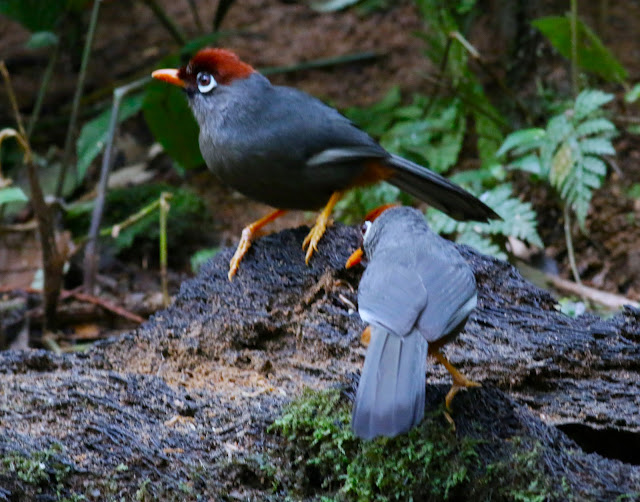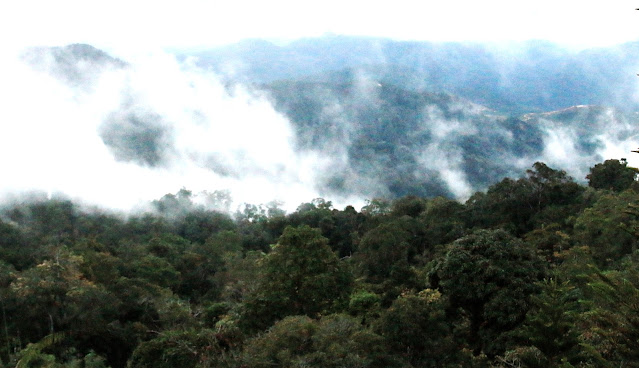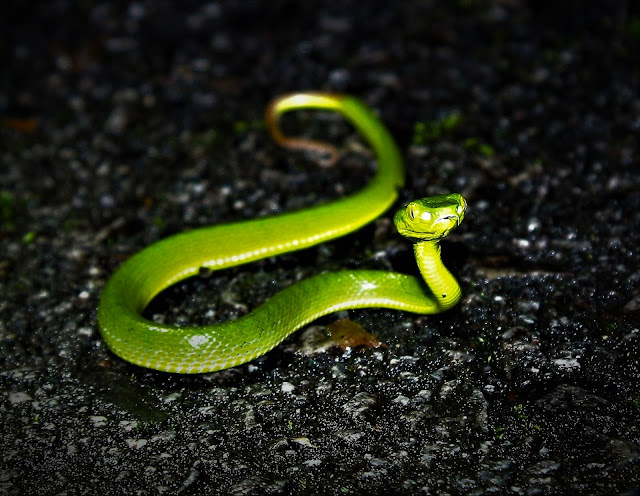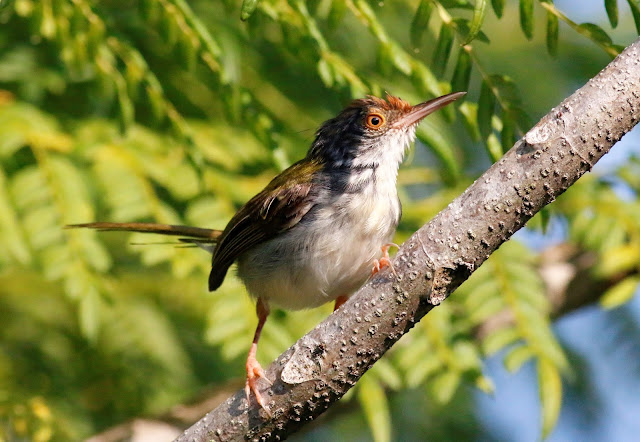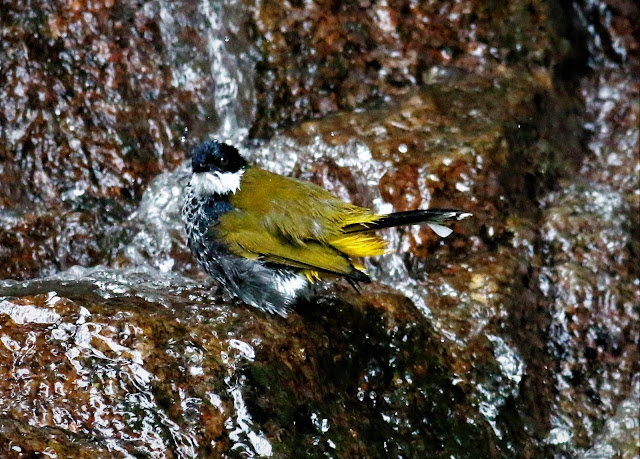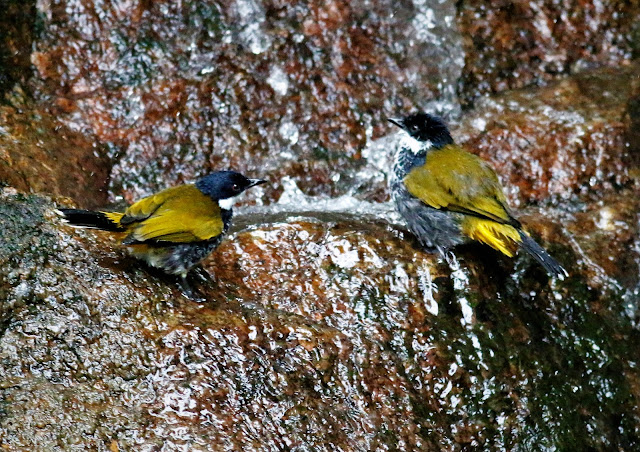If you don't mind the usual weekend crowd and the sound of big bikes going around the narrow winding road and its small town centre, Fraser's Hill has still got what it takes - insects, birds, butterflies, and cool weather. The news of a very confiding Rusty-naped Pitta was buzzing in my ears for couple of days before I decided to give it a try for this illusive and cryptic bird. So after almost 4.5 years of absence, off I went to the rustic and iconic hill which should by now be part of Malaysia's heritage.
The ever famous clock in the center of the town. Still standing there "dengan megahnya" (proudly) after so many years. After getting some tips on the 'star' pitta from the "tok guru" of the hill (Aneh Durai) I went straight to the birding "port" (as birders like to call their favourite birding site). After climbing a muddy terrain I finally reached the port at 10.30am. There were already two birders patiently waiting there.
I waited and waited but the pitta did not show up. Instead it was other interesting birds (both common and uncommon) which turned up.
White-tailed Robin
Instead of coming out in front of the "shooting" range, it decided to use the side entrance. Quietly it hop into view. This posture reminds me of a dancing bird in Papua New Guinea (the Western Parotia).
This is an uncommon bird and my first lifer of the day. In absence of the targeted pitta, this Robin provided some entertainment.
It was everywhere - at the side, behind and finally in front of us. It looks like it was trying to check us out.
Throughout its presence it did not make any noise / calls at all!
Chestnut-capped Laughingthrush
There were at least 6 of them - taking turns to fly in and out from the port.
Watching closely from above is this friendly little flycatcher
This is the most common flycatcher that you will come across in Fraser's Hill.
Besides birds, other mammals also came to entertain us.
This is a very inquisitive rat like shrew called "Gymnure".
Three-striped squirrel also came swinging by.
After a long wait then came my second lifer of the day.
Buff-breasted Babbler
It was also silent.
Then finally the 'star' bird came into view and it is a female.
According to Aneh Durai - the pitta will appear in the early morning and then its last call will be at 5.45pm. True enough it came at 5.50pm just when I am about to pack up. It came down from the middle of the port. The earlier two birders have left. Two lucky uncles came to join me at 5.00pm. At this time the port is almost dark and with my low budget camera system, this is the best I could muster. It appear less than a minute before heading back to her "home".
After securing my third lifer of the day, it's time to check-in and take my dinner.
Enjoying the cool mountain air.
After my simple dinner, it's time to go out again. This time is to look for those creepy crawly creatures of the night. I joined Steven Wong herping group which happened to be doing a 'tour of duty' as well.
The first creepy crawly creature we came across was this black spider.
Malaysian Black Trapdoor Spider (Liphistius malayanus)
There were quite a number of this Huntsman spider seen by our group of 9 pax.
Coremiocnemis hoggi (Malaysian Purple-femur Tarantula)
As we venture further, more 'things' came out. This time are some froggies.
Malayan Flying Frog (Rhacophorus prominanus)
This is the best image I have taken of a frog so far.
Look at its cute web feet !
The next frog is kinda of unique. You can actually hear it calling from a distance.
Malayan Treehole Frog (Metaphrynella pollicaris)
Most of the time according to Steven Wong our guide and herp guru, this frog will be calling from inside a tree hole and their calls can sound like a short "pop" or a longer "poop". Interesting right !
You can seen its pale looking tongue sticking out. Apparently its favourite diet is earthworms !
It's actually just a tiny snake - just about 25cm long.
You can see the iridescence colours of its scale.
As we were driving back, Steven Wong suddenly pressed the emergency brake and said "snake" ! Without a second thought yours truly - the hero immediately jump out of the car and asked "where"? Steven Wong then cautioned "watch out - don't move". At that time I was looking up on the trees but the teeny-weeny snake (of just 12 in long) was actually right in the middle of the road - just a few feet away from me.
This is a juvenile female Siamese Peninsula Pitviper (Trimeresurus popeia fucatus)
Although its venom might not kill you but at this size it can still able to make you sick and suffer for many months.
It appears like this mushroom glows yellowish at night.
The next morning it's birding time again.
Saw this Large Woodshrike at about 7.30am. There were two of them.
Not too far away came this "one-tailed" Lesser Racket-tailed Drongo.
This looks like a Black-nest Swiflet
Long-tailed Sibia having its early morning snack. There were about 15 of them.
This Blue-winged Minla also came out early to look for breakfast.
As the sun came out, things look a bit brighter.
Streaked Spiderhunter
The commonest spiderhunter you can find in Fraser's Hill.
Beside the Black-browed Barbet, you should also be able to see this Fire-tufted Barbet quite often here.
It wants to do a tango.
Mountain Fulvetta
This is another common bird in this hill station.
The next bird is the most iconic and friendly bird of them all !
Silver-eared Mesia
It should be made a mascot bird for Fraser's Hill.
Standing tall and looking majestically !
There are still a few more birds in Fraser's Hill which I have hoped to see in the future. With the new Novotel coming up from the once famous birding spot hopefully it will provide a more decent place to stay and not ruin the serenity of the entire place.
UNTIL THEN - STAY SAFE AND ENJOY THE BIRDS AROUND YOU !






